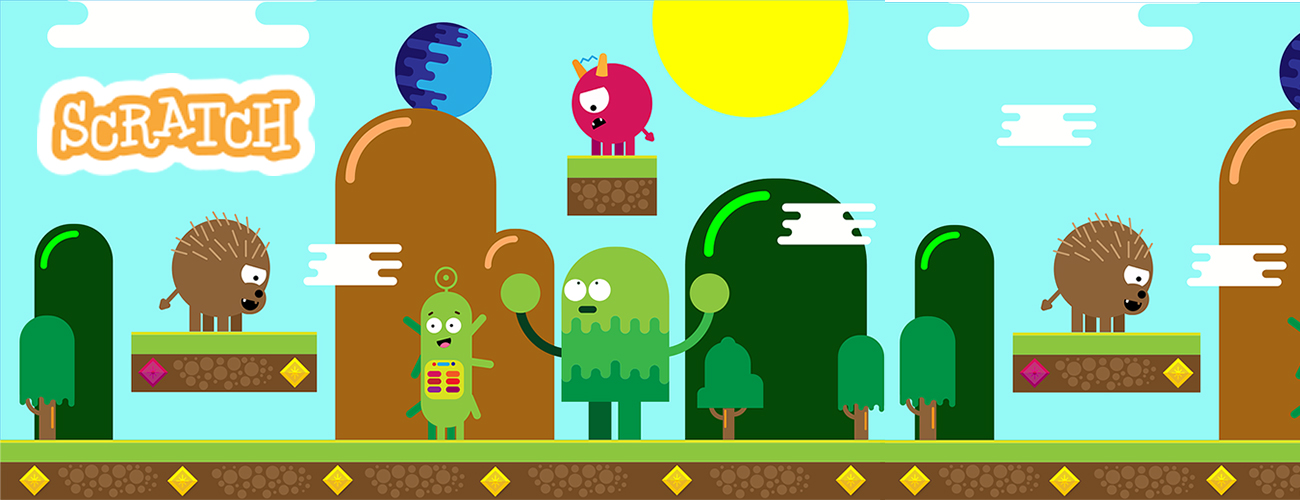
What is it?
Our programming course is designed to teach the fundamental skills of programming in an easy-to-understand way. Our course uses Scratch, a program designed by MIT to help anyone learn programming at a basic level. Scratch uses block-based programming. Programs are built by joining together different blocks with different functions in a coherent and logical way. Each section is divided by colors for easy understanding and retention. The goal is to enhance critical thinking skills as well as illuminate previously unknown potential careers or interests within the children who will be taught this course. It is not necessary to know programming to be able to teach this course since it was made in such a way that anyone with or without previous knowledge of programming could follow it.
As part of the class, the videos were pre-recorded and included in each of the lessons. Each lesson contains a video with everything needed to teach this course (Theory Presentation, basic concepts, exercises and a biblical message). One of the unique things about our programming course is that all the videos are done in Spanish.
It is a unique opportunity for children to learn programming in their native language, taught by someone from Mexico. But do not worry! The videos have English subtitles, making it easy for non-Spanish speakers to follow along and learn as well.
The course is divided into seven lessons. The first is an introductory lesson that prepares students to learn from scratch. The next six lessons cover different programming concepts, and the difficulty of application increases as students progress through the course. Each lesson has PowerPoint presentations with the necessary theory for this course, as well as practical exercises that will be carried out step by step in order to better understand and also has a brief biblical teaching.
English and Spanish versions are included in the course to allow people who speak both languages to prepare and teach the course.
The PowerPoints are divided into two sections, the teacher section and the student section. The teachers section contains instructions and all the information needed to teach students in an informed and efficient manner. It also contains some "homework" for teachers to make sure they understand the material they are teaching. The student section contains detailed descriptions of each of the blocks and what they do, as well as instructions on when to watch the instructional videos.
Our program is designed for full use without the need for a network connection. Each video and presentation, as well as the Scratch program, can be downloaded in advance and used without an Internet connection. This feature was intentionally planned to allow this course to be delivered in more remote areas that might not have consistent internet.
Why Scratch?
We chose Scratch for this course for several reasons. One of the main reasons is that the program is lightweight and can be used on almost any quality of computer. It's easy to download and set up, even for someone who has never programmed before. MIT wanted to make the program easy to use and their efforts are reflected.
Second, Scratch supports dozens of languages and you can easily switch to any of them with the click of a button. This feature makes it incredibly easy for a teacher who only speaks English to help teach a student who only speaks Spanish.
Third, this course is intended for middle and high school students. Often these children will not be very familiar with a computer. Scratch is designed to combat this problem. Its interface is intuitive and easy to understand. MIT designed Scratch specifically for children of this age and experience level to use.
Scratch is a visual programming development environment. This terminology means that everything has a drawing or image that accompanies it. Programs that students design will make a creature or object, called a Sprite, move, talk, and perform other more complex tasks. This visual learning environment allows for instant feedback, allowing students to make corrections or changes as needed.
Summary of Lessons
Lesson 1: It is the introduction to the entire course, this will show all the basics related to the installation of the program, the basic concepts that will be used throughout the course, as well as a brief tour of the Scratch application and an explanation how each class should be taught in this programming course.
Lesson 2: This lesson is probably the longest of the entire course since it consists of 6 exercises where the first 2 sections of blocks in Scratch (Movement and Appearance) will be shown, it also shows the basic tools that will be used in the course of all the lessons.
Lesson 3: One of the funniest sections of all is surely this, since students will be able to learn to program with the Sounds and Events blocks and where they will be able to program a very simple and fun little game.
Lesson 4: This lesson is focused on the Control blocks that allow the user to control the Sprites, scenarios, code to perform specific tasks such as pausing the animation or creating loops, etc.
Lesson 5: This lesson is responsible for introducing mathematical functions through the blocks of conditions, sensors and operations.
Lesson 6: In this lesson teachers show students how to create and manipulate Variable blocks, blocks that will be very important for the final lesson.
Lesson 7: The final lesson combines everything the students have learned so far. This final project has them create a somewhat complex Bible-themed game within Scratch. The game uses resources not found natively in Scratch. These resources will be provided to you, the teacher, along with the rest of the presentation and videos.

